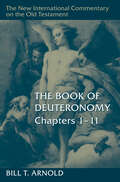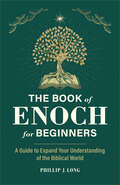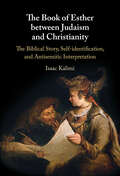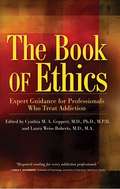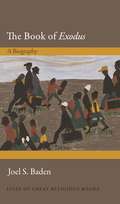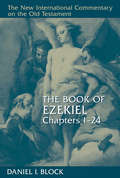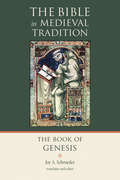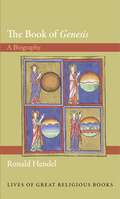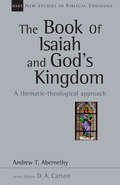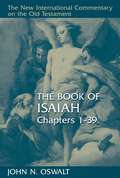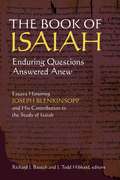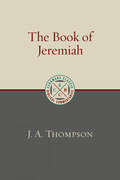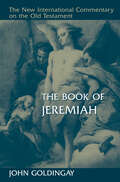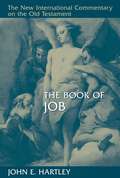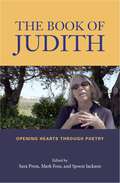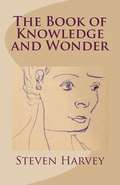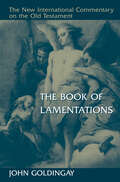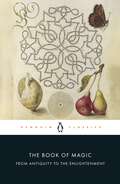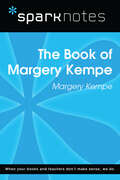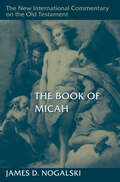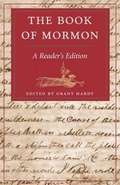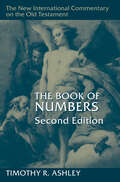- Table View
- List View
The Book of Deuteronomy, Chapters 1–11 (New International Commentary on the Old Testament (NICOT))
by Bill T. Arnold&“The book of Deuteronomy can rightly be called a compendium of the most important ideas of the Old Testament.&” So begins this commentary on the book of Deuteronomy, which Bill Arnold treats as the heart of the Torah and the fulcrum of the Old Testament—crystallizing the themes of the first four books of the Bible and establishing the theological foundation of the books that follow.After a thorough introduction that explores these and other matters, Arnold provides an original translation of the first eleven chapters of Deuteronomy along with verse-by-verse commentary (with the translation and commentary of the remaining chapters following in a second volume). As with the other entries in the New International Commentary on the Old Testament, Arnold remains rooted in the book&’s historical context while focusing on its meaning and use as Christian Scripture today. Ideal for pastors, students, scholars, and interested laypersons, this commentary is an authoritative yet accessible companion to the book of Deuteronomy.
The Book of Enoch for Beginners: A Guide to Expand Your Understanding of the Biblical World
by Phillip J. LongJourney through the strange world of the Book of Enoch Fragments of the Book Enoch were found among the Dead Sea Scrolls yet were not published until 1978. Considered one of the lost books of the Bible, "1 Enoch" features unique writing on fallen angels, the great flood of Genesis, the final judgment, and the prophecy of a future messiah. Use this guide to delve into the key events and figures of the text, from The Book of Watchers to The Epistle of Enoch. An engaging introduction—Dive right in with a summary of the subject matter and key facts about the history and content. Easily digestible sections—Gain a thorough understanding of Enoch through a combination of summaries, key verses, and enlightening commentary, all designed for beginning students. Rarely covered material—Find information on the lesser-known aspects of the book of Enoch, complete with material on how all five sections can enhance our understanding of the Bible, early Christianity, and early Judaism. Demystify the Book of Enoch with The Book of Enoch for Beginners
The Book of Esther between Judaism and Christianity
by Isaac KalimiThe book of Esther is one of the most challenging books in the Hebrew Bible/Old Testament, not only because of the difficulty of understanding the book itself in its time, place, and literary contexts, but also for the long and tortuous history of interpretation it has generated in both Jewish and Christian traditions. In this volume, Isaac Kalimi addresses both issues. He situates 'traditional' literary, textual, theological, and historical-critical discussion of Esther alongside comparative Jewish and Christian interpretive histories, showing how the former serves the latter. Kalimi also demonstrates how the various interpretations of the Book of Esther have had an impact on its reception history, as well as on Jewish-Christian relations. Based on meticulous and comprehensive analysis of all available sources, Kalimi's volume fills a gap in biblical, Jewish, and Christian studies and also shows how and why the Book of Esther became one of the central books of Judaism and one of the most neglected books in Christianity.
The Book of Ethics: Expert Guidance For Professionals Who Treat Addiction
by Laura Weiss Roberts Cynthia GeppertThe definitive book on ethics for chemical dependency treatment professionals.The treatment of addiction as a biological, psychological, social, and spiritual disease requires a high standard of ethical knowledge and professional skill. This groundbreaking, reader-friendly guide to contemporary ethical issues informs and challenges health care professionals, students, and faculty with a thorough and compassionate examination of the dilemmas faced when providing care for individuals suffering from substance use problems or addiction.Renowned psychiatric ethicists Cynthia Geppert and Laura Weiss Roberts tackle issues of autonomy, respect for persons, confidentiality, truth telling and non-maleficence--setting the standard for contemporary ethical practices. These challenges are illuminated with real-world case examples that show potential effects on diverse patient populations.
The Book of Exodus: A Biography (Lives of Great Religious Books #48)
by Joel S. BadenAn essential biography of one of the Bible’s most powerful and inspiring booksExodus is the second book of the Hebrew Bible, but it may rank first in lasting cultural importance. It is here that the classic biblical themes of oppression and redemption, of human enslavement and divine salvation, are most dramatically expressed. Joel Baden tells the story of this influential and enduring book, tracing how its famous account of the Israelites’ journey to the promised land has been adopted and adapted for millennia, often in unexpected ways.Baden draws a distinction between the Exodus story and the book itself, which is one of the most multifaceted in the Bible, containing poems, law codes, rituals, and architectural plans. He shows how Exodus brings together an array of oral and written traditions from the ancient Middle East, and how it came to be ritualized in the Passover Seder and the Eucharist. Highlighting the remarkable resilience and flexibility of Exodus, Baden sheds light on how the bestowing of the Torah to Moses on Mount Sinai divided Jewish and Christian thinkers, on the importance of Exodus during the Reformation and the American Revolution, and on its uses in debates for and against slavery. He also traces how the defining narrative of ancient Israel helped to define Mormon social identity, the American civil rights movement, and liberation theology.Though three thousand years old, the Exodus—as history, as narrative, as metaphor, as model—continues to be vitally important for us today. Here is the essential biography of this incomparable spiritual masterpiece.
The Book of Ezekiel, Chapters 1–24 (The\new International Commentary On The Old Testament Ser.)
by Daniel I. BlockTo most modern readers the book of Ezekiel is a mystery. Few can handle Ezekiel's relentless denunciations, his unconventional antics, his repetitive style, and his bewildering array of topics. This excellent commentary by Daniel I. Block makes sense of this obscure and often misunderstood prophet and demonstrates the relevance of Ezekiel's message for the church today.
The Book of Genesis (The Bible in Medieval Tradition (BMT))
by Joy A. SchroederRetrieves rich historical biblical insights for readers of Genesis today In this latest addition to the Bible in Medieval Tradition series, Joy Schroeder provides substantial excerpts — none previously available in English — from seven noteworthy medieval biblical interpreters who commented on Genesis between the ninth and fifteenth centuries. Representing a chronological and geographical range of authors — including Hildegard of Bingen, Nicholas of Lyra, and Denis the Carthusian — these clear, readable translations illustrate the rich diversity of medieval approaches to biblical interpretation. The commentary covers the entire book of Genesis and includes an in-depth introduction by Schroeder that locates each of the medieval authors within his or her context.
The Book of Genesis (The Bible in Medieval Tradition (BMT))
by Joy A. SchroederRetrieves rich historical biblical insights for readers of Genesis today In this latest addition to the Bible in Medieval Tradition series, Joy Schroeder provides substantial excerpts — none previously available in English — from seven noteworthy medieval biblical interpreters who commented on Genesis between the ninth and fifteenth centuries. Representing a chronological and geographical range of authors — including Hildegard of Bingen, Nicholas of Lyra, and Denis the Carthusian — these clear, readable translations illustrate the rich diversity of medieval approaches to biblical interpretation. The commentary covers the entire book of Genesis and includes an in-depth introduction by Schroeder that locates each of the medieval authors within his or her context.
The Book of Genesis: A Biography (Lives of Great Religious Books #14)
by Ronald HendelAn essential biography of one of the Bible's most influential booksDuring its 2,500-year life, the book of Genesis has been the keystone to almost every important claim about reality, humanity, and God in Judaism and Christianity. And it continues to play a central role in debates about science, politics, and human rights. With clarity and skill, acclaimed biblical scholar Ronald Hendel provides a panoramic history of this iconic book, exploring its impact on Western religion, philosophy, science, politics, literature, and more.Hendel traces how Genesis has shaped views of reality, and how changing views of reality have shaped interpretations of Genesis. Literal and figurative readings have long competed with each other. Hendel tells how Luther's criticisms of traditional figurative accounts of Genesis undermined the Catholic Church; how Galileo made the radical argument that the cosmology of Genesis wasn't scientific evidence; and how Spinoza made the equally radical argument that the scientific method should be applied to Genesis itself. Indeed, Hendel shows how many high points of Western thought and art have taken the form of encounters with Genesis--from Paul and Augustine to Darwin, Emily Dickinson, and Kafka.From debates about slavery, gender, and sexuality to the struggles over creationism and evolution, Genesis has shaped our world and continues to do so today. This wide-ranging account tells the remarkable story of the life of Genesis like no other book.
The Book of Isaiah and God's Kingdom: A Thematic-Theological Approach (New Studies in Biblical Theology #Volume 40)
by Andrew AbernethyThe book of Isaiah has nourished the church throughout the centuries. However, its massive size can be intimidating; its historical setting can seem distant, opaque, varied; its organization and composition can seem disjointed and fragmented; its abundance of terse, poetic language can make its message seem veiled—and where are those explicit prophecies about Christ? These are typical experiences for many who try to read, let alone teach or preach, through Isaiah. Andrew Abernethy's conviction is that thematic points of reference can be of great help in encountering Isaiah and its rich theological message. In view of what the structure of the book of Isaiah aims to emphasize, this New Studies in Biblical Theology volume employs the concept of "kingdom" as an entry point for organizing the book's major themes. In many respects, Isaiah provides a people living amidst imperial contexts with a theological interpretation of them in the light of YHWH's past, present and future sovereign reign. Four features of "kingdom" frame Abernethy's study: God, the King; the lead agents of the King; the realm of the kingdom and the people of the King. While his primary aim is to show how "kingdom" is fundamental to Isaiah when understood within its Old Testament context, interspersed canonical reflections assist those who are wrestling with how to read Isaiah as Christian Scripture in and for the church. Addressing key issues in biblical theology, the works comprising New Studies in Biblical Theology are creative attempts to help Christians better understand their Bibles. The NSBT series is edited by D. A. Carson, aiming to simultaneously instruct and to edify, to interact with current scholarship and to point the way ahead.
The Book of Isaiah, Chapters 1–39 (The\new International Commentary On The Old Testament Ser.)
by John N. OswaltThe first of John N. Oswalt's two-part study of the book of Isaiah for the NICOT series, this commentary on chapters 1û39 combines theological acumen, literary sensitivity, philological expertise, and historical knowledge to present a faithful and accurate reading of one of the Old Testament's most important books. In the introduction to this work, Oswalt considers Isaiah's background, unity of composition, date and authorship, canonicity, Hebrew text, theology, and problems of interpretation, and he offers a select bibliography for further research. Oswalt also provides substantial discussions of several issues crucial to the book of Isaiah. He notes, for example, that scholars often divide Isaiah into three divisions, with chapters 1–39 addressing Isaiah's contemporaries in the eighth century B.C., chapters 40–55 presupposing the exile of the sixth century, and chapters 56–66 presupposing the eventual return from exile. While taking this scholarship into account Oswalt defends the unity of the prophetic book and argues convincingly that the whole book can be attributed to the Isaiah of the eighth century. The commentary proper, based on Oswalt's own translation of the Hebrew text, provides pastors, scholars, and students with a lucid interpretation of the book of Isaiah in its ancient context as well as an exposition of its message for today.
The Book of Isaiah: Enduring Questions Answered Anew
by Richard J. Bautch J. Todd HibbardA fresh window on Isaiah studies today Representing the highest echelon of Isaiah studies, this volume explores distinct issues that arise from the critical study of the text of Isaiah. The contributors acknowledge and comment on the exegetical contributions of distinguished biblical scholar Joseph Blenkinsopp, providing distinction and coherence to the collection. The publication between 2000 and 2004 of Blenkinsopp's 3-volume Anchor Bible commentary on Isaiah marked a significant development in Isaiah studies. Many of the articles and books now published in the field cite Blenkinsopp, testifying to how his commentary is influencing and helping shape the future direction of Isaiah studies. This volume, with its focus on his contributions, provides a fresh look at Isaiah studies in the twenty-first century.Contributors: Rainer Albertz Klaus Baltzer Hans M. Barstad Ulrich Berges Willem A. M. Beuken Philip Davies Hyun Chul Paul Kim Peter Marinkovic Andreas Schuele Jacob Stromberg Marvin A. Sweeney Lena-Sofia Tiemeyer Patricia K. Tull H. G. M. Williamson
The Book of Jeremiah (Eerdmans Classic Biblical Commentaries (ECBC))
by J. A. ThompsonThe Old Testament prophets played a crucial role in the history of Israel. Although there were many prophets who brought the message of God to his people, we have recordsof only a few. Of these, our knowledge of Jeremiah is probably the most complete. In this commentary for scholars and pastors, originally part of the New International Commentary on the Old Testament, J. A. Thompson examines the book of Jeremiah with its message urging the people of Israel to be true to their covenant Lord and to live in conformity with his covenant requirements. Thompson begins his study by looking at the role of the prophets in Israel and at Jeremiah&’s place among them. He then discusses the historical setting of Jeremiah&’s message. From this background, Thompson moves to an examination of the book of Jeremiah itself, focusing on its structure and composition before considering some important issues for exegesis—the date of Jeremiah&’s call, the significance of the symbolic actions he performed, and the relationship between Jeremiah and Hosea. In the last part of his extensive introduction, Thompson examines the text and poetic forms of Jeremiah.
The Book of Jeremiah: The Book, The Man, The Message (New International Commentary on the Old Testament (NICOT))
by John GoldingayOf the Major Prophets, Jeremiah is perhaps the least straightforward. It is variously comprised of stories about the prophet Jeremiah, exchanges between Jeremiah and Yahweh, and messages directly from Yahweh—meaning a consciousness of form is essential to the understanding of its content. At times it is written in poetry, resembling Isaiah, while at other times it is written in prose, more similar to Ezekiel. And it is without doubt the darkest and most threatening of the Major Prophets, inviting comparisons to Amos and Hosea. John Goldingay, a widely respected biblical scholar who has written extensively on the entire Old Testament, navigates these complexities in the same spirit as other volumes of the New International Commentary on the Old Testament series—rooted in Jeremiah&’s historical context but with an eye always trained on its meaning and use as Christian Scripture. After a thorough introduction that explores matters of background, composition, and theology, Goldingay provides an original translation and verse-by-verse commentary of all fifty-two chapters, making this an authoritative and indispensable reference for scholars and pastors as they engage with Jeremiah from a contemporary Christian standpoint.
The Book of Job (The\new International Commentary On The Old Testament Ser.)
by John E. Hartley“In the Old Testament we read God’s word as it was spoken to his people Israel. Today, thousands of years later, we hear in these thirty-nine books his inspired and authoritative message for us.”These twin convictions, shared by all of the contributors to The New International Commentary on the Old Testament, define the goal of this ambitious series of commentaries. For those many modern readers who find the Old Testament to be strange and foreign soil, the NICOT series serves as an authoritative guide bridging the cultural gap between today’s world and the world of ancient Israel. Each NICOT volume aims to help us hear God’s word as clearly as possible.Scholars, pastors, and serious Bible students will welcome the fresh light that this commentary series casts on ancient yet familiar biblical texts. The contributors apply their proven scholarly expertise and wide experience as teachers to illumine our understanding of the Old Testament. As gifted writers, they present the results of the best recent research in an interesting manner.Each commentary opens with an introduction to the biblical book, looking especially at questions concerning its background, authorship, date, purpose, structure, and theology. A select bibliography also points readers to resources for their own study. The author’s own translation from the original Hebrew forms the basis of the commentary proper. Verse-by-verse comments nicely balance in-depth discussions of technical matters — textual criticism, critical problems, and so on — with exposition of the biblical writer’s theology and its implications for the life of faith today.
The Book of Judges (Old Testament Readings)
by Marc Zvi BrettlerThe Book of Judges has typically been treated either as a historical account of the conquest of Israel and the rise of the monarch, or as an ancient Israelite work of literary fiction. In this new approach, Brettler contends that Judges is essentially a political tract, which argues for the legitimacy of Davidic kingship. He skilfully and accessibly shows the tension between the stories in their original forms, and how they were altered and reused to create a book with a very different meaning. Important reading for all those studying this part of the Bible.
The Book of Judith: Opening Hearts Through Poetry
by Sara Press, Mark Foss and Spoon JacksonAn homage to the life of poet, writer, and teaching artist Judith Tannenbaum and her impact on incarcerated and marginalized students.The Book of Judith honors Judith Tannenbaum but also reflects, through both form and content, on the complexities of seeing both the parts and the whole. The book presents different aspects of Judith—poet, teaching artist, friend, mentor, colleague—through a collection of original poetry, prose, essay, illustration, and fiction from 33 contributors. In so doing, it echoes her own determination to perceive contradiction without judgment. For the next generation of teaching artists in Corrections and elsewhere, the book serves as an inspiration on the qualities needed to survive and thrive in a multi-faceted, ever-changing environment.The book is divided into four sections, separated by riveting black and white pencil drawings inspired by the lives of those serving life in prison without possibility of parole. In Unfinished Conversations, contributors share their bond with Judith Tannenbaum through prose and excerpts from letters both real and imagined. In the second section, After December, poets reflect on the life, artistry, and legacy of Judith. The third section, Looking and Listening, focuses on the truth-seeking qualities that Judith brought to her work. The fourth section, Legacy, features work from winners of an award and a fellowship bestowed in her name.
The Book of Knowledge and Wonder
by Steven HarveyThe Book of Knowledge and Wonder is a memoir about claiming a legacy of wonder from knowledge of a devastating event. In some ways it has the feel of a detective story in which Steven Harvey pieces together the life of his mother, Roberta Reinhardt Harvey, who committed suicide when he was eleven, out of the 406 letters she left behind. Before he read the letters his mother had become little more than her death to him, but while writing her story he discovered a woman who, despite her vulnerability to depression, had a large capacity for wonder and a love of familiar things, legacies that she passed on to him. The book tackles subjects of recent fascination in American culture: corporate life and sexism in the fifties, mental illness and its influence on families, and art and learning as a consolation for life's woes, but in the end it is the perennial theme of abiding love despite the odds that fuels the tale. As the memoir unfolds, his mother changes and grows, darkens and retreats as she gives up her chance at a career in nursing, struggles with her position as a housewife, harbors paranoid delusions of having contracted syphilis at childbirth, succumbs to a mysterious, psychic link with her melancholic father, and fights back against depression with counseling, medicine, art, and learning. Harvey charts the way, after his mother's death, that he blotted out her memory almost completely in his new family where his mother was rarely talked about, a protective process of letting go that he did not resist and in a way welcomed, but the book grows out of a nagging longing that never went away, a sense of being haunted that caused the writer to seek out places alone-dribbling a basketball on a lonely court, going on long solitary bicycle rides, walking away from his family to the edge of a mountain overlook, and working daily at his writing desk-where he might feel her presence. In the end, the loss cannot be repaired. Her death, like a camera flash in the dark, blotted out all but a few lingering memories of her in his mind, but the triumph of the book is in the creative collaboration between the dead mother, speaking to her son in letters, and the writer piecing together the story from photographs, snatches of memory, and her words so that he can, for the first time, know her and miss her, not some made up idea of her. The letters do not bring her back-he knows the loss is irrevocable-but as he shaped them into art, the pain, that had been nothing more than a dull throb, changed in character, becoming more diffuse and ardent, like heartache.
The Book of Lamentations (New International Commentary on the Old Testament (NICOT))
by John GoldingayThe book of Lamentations is one of the most vivid representations of grief and trauma in the Hebrew Bible. Written in the wake of the fall of Jerusalem to the Babylonian Empire, it is comprised of five poems of twenty-two stanzas each, in a manner of tight formal unity unparalleled by any other work in the Scriptures. In this volume, widely respected Old Testament scholar John Goldingay analyzes these and other aspects of Lamentations while keeping a constant eye on the book&’s meaning and use as Christian Scripture. After a thorough introduction that explores matters of background, composition, and theology, Goldingay provides an original translation of the book from the Masoretic text along with verse-by-verse commentary.
The Book of Magic: From Antiquity to the Enlightenment
by Brian Copenhaver'. . . as when iron is drawn to a magnet, camphor is sucked into hot air, crystal lights up in the Sun, sulfur and a volatile liquid are kindled by flame, an empty eggshell filled with dew is raised towards the Sun . . .'An odd feature of the Bible is that it is full of stories featuring forms of magic and possession - from Joseph battling with Pharaoh's wizards to the supernatural actions of Jesus and his disciples. As, over the following centuries, the Christian church attempted to stamp out 'deviant' practices, there was a persistent interest in magic that drew strength from this Biblical validation. A strange blend of mumbo-jumbo, fraud and deeply serious study, magic was central to the European Renaissance, fascinating many of its greatest figures. Brian Copenhaver's wonderful anthology will be welcomed by everyone from those with the most casual interest in the magical tradition to anyone drawn to the Renaissance and the tangled, arcane roots of the scientific tradition.
The Book of Margery Kempe (SparkNotes Literature Guide Series)
by SparkNotesThe Book of Margery Kempe (SparkNotes Literature Guide) by Margery Kempe Making the reading experience fun!Created by Harvard students for students everywhere, SparkNotes is a new breed of study guide: smarter, better, faster.Geared to what today's students need to know, SparkNotes provides:chapter-by-chapter analysis explanations of key themes, motifs, and symbols a review quiz and essay topicsLively and accessible, these guides are perfect for late-night studying and writing papers.
The Book of Micah (The\new International Commentary On The Old Testament Ser.)
by James D. NogalskiWhat is the balance between judgment and hope? Micah spoke powerfully to the people of Judah millennia ago. His prophecy has the same power to change the minds and hearts of Christians today. As a volume of the New International Commentary on the Old Testament, James D. Nogalski&’s fresh commentary on Micah is academically serious and pastorally relevant. Based on Nogalski&’s original translation of the Hebrew text, this commentary takes seriously the historical and theological contexts of the book of Micah. The thorough introduction considers the book&’s literary form, its composition, and its function in the canon, especially within the Book of the Twelve. Ample notes point readers to the most relevant, up-to-date critical scholarship. Nogalski explicates Micah&’s major themes, including fidelity to Yahweh, abuses of power, and the intriguing juxtaposition of judgment and hope for God&’s people. Combining scholarly rigor with an evangelical point of view, The Book of Micah serves as the perfect companion for scholars, students, and pastors seeking to understand this essential prophet.
The Book of Mormon: A Reader's Edition
by Grant HardyRegarded as sacred scripture by millions, the Book of Mormon -- first published in 1830 -- is one of the most significant documents in American religious history. This new reader-friendly version reformats the complete, unchanged 1920 text in the manner of modern translations of the Bible, with paragraphs, quotations marks, poetic forms, topical headings, multichapter headings, indention of quoted documents, italicized reworkings of biblical prophecies, and minimized verse numbers. It also features a hypothetical map based on internal references, an essay on Book of Mormon poetry, a full glossary of names, genealogical charts, a basic bibliography of Mormon and non-Mormon scholarship, a chronology of the translation, eyewitness accounts of the gold plates, and information regarding the lost 116 pages and significant changes in the text. The Book of Mormon claims to be the product of three historical interactions: the writings of the original ancient American authors, the editing of the fourth-century prophet Mormon, and the translation of Joseph Smith. The editorial aids and footnotes in this edition integrate all three perspectives and provide readers with a clear guide through this complicated text. New readers will find the story accessible and intelligible; Mormons will gain fresh insights from familiar verses seen in a broader narrative context. This is the first time the Book of Mormon has been published with quotation marks, select variant readings, and the testimonies of women involved in the translation process. It is also the first return to a paragraphed format since versification was added in 1879.
The Book of Numbers (New International Commentary on the Old Testament (NICOT))
by Timothy R. AshleyThe book of Numbers tells a story that has two main characters—God and Israel. The way the story is told sounds odd and often harsh to readers today. In spite of the difficulties imposed by Numbers on today&’s readers, the main point of the book is of immense importance for God&’s people in any age: exact obedience to God is crucial.This comprehensive and erudite commentary presents a thorough explication of this significant Hebrew text. Timothy Ashley&’s introduction discusses such questions as structure, authorship, and theological themes, and it features an extended bibliography of major works on the book of Numbers. Then, dividing the text of Numbers into five major sections, Ashley&’s commentary elucidates the theological themes of obedience and disobedience that run throughout the book. His detailed verse-by-verse comments are intended primarily to explain the Hebrew text of Numbers as we have it rather than to speculate on how the book came to be in its present form. This second edition includes revisions that reflect Ashley&’s decades of experience with the book of Numbers, as well as updates to the footnotes and bibliography that include many important works published in the last thirty years. With these new features, Ashley&’s commentary solidifies its place as the church&’s most faithful and definitive reference on the book of Numbers.
The Book of Ornamental Alphabets: Ancient & Mediaeval
by Alan Anderson F. G. DelamotteWhether you're a type nerd, an illustrator or a professional designer, The Book Of Ornamental Alphabets is the perfect sourcebook. FIRST PUBLISHED IN 1858, Freeman Delamotte's Ornamental Alphabets Ancient & Mediæval was an immediate hit, and a huge influence on generations of designers in every medium.An idiosyncratic, personal selection of over fifty scripts and typefaces, it remains guaranteed to inspire anyone with an interest in lettering, from designers and artists to tattooists, hand-letterers, and calligraphers.
